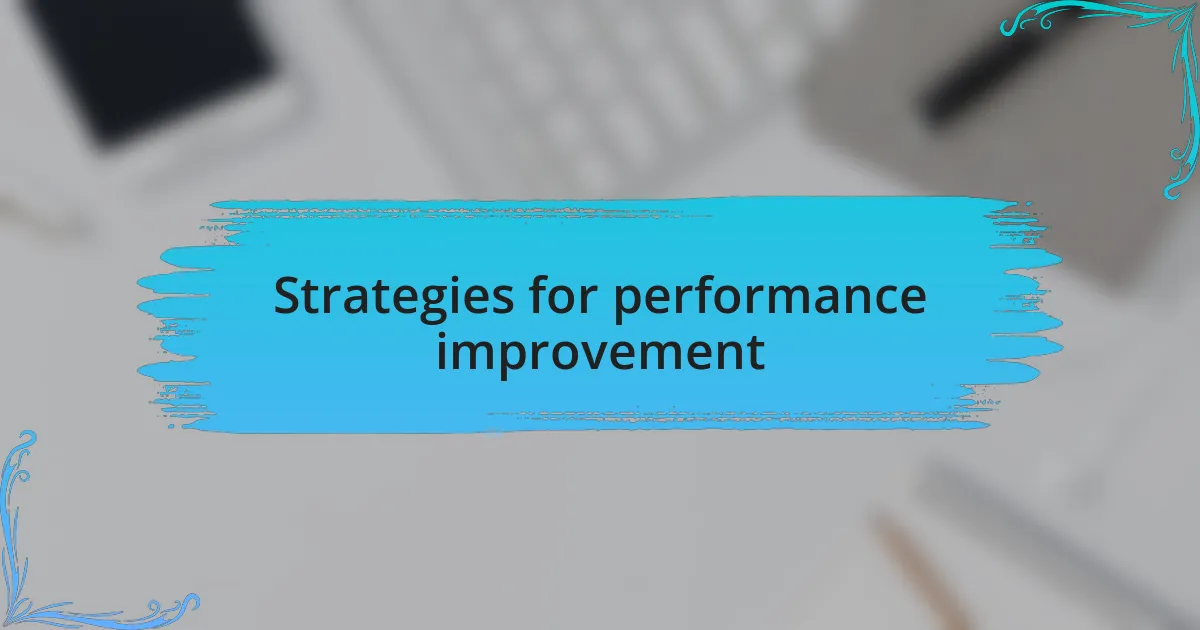Key takeaways:
- Test environments are essential for identifying bugs and performance issues before deployment, reducing the risk of major setbacks.
- Optimization of test environments can lead to significant time and cost savings, while enhancing team morale and productivity.
- Automated testing tools, like Selenium and Postman, improve reliability and efficiency in the testing process.
- Regular maintenance, meticulous documentation, and prioritization of test scenarios are best practices that enhance the effectiveness of testing environments.

Understanding test environments
Test environments are crucial for the app development process. They simulate the conditions in which an application will run, allowing developers to catch bugs and performance issues before going live. I remember the anxiety I felt during a recent project when a last-minute bug surfaced in a production environment; it made me realize just how essential a solid testing ground is for delivering quality software.
These environments can vary widely, from local setups on a developer’s machine to complex cloud-based systems that mimic user interactions. I often think about how much time I saved by creating a replica of our production environment in the cloud. Have you ever had a scenario where a small oversight turned into a major setback? This is why a well-defined test environment is not just a luxury; it’s a necessity for minimizing risks.
It’s not just about the technology, either; understanding how different configurations affect your application is key. I’ve seen teams struggle simply because they didn’t account for server configurations or third-party integrations in their test environments. By reflecting on your unique requirements and potential challenges, you can create a more effective testing strategy. What elements do you think are most critical in your test environment setup?

Importance of optimization
The importance of optimization in test environments cannot be overstated. I remember when I first delved into app development; I thought testing was just about running the application. It wasn’t until I faced performance lags during a demo that I recognized the need for a meticulously optimized environment. Are you aware of how your setup can impact user experience? The reality is that a well-optimized test environment allows developers to identify potential bottlenecks before they reach the end users.
Optimizing these environments can lead to substantial time and cost savings. In one project, by enhancing our test environment, we reduced the time spent on debugging by nearly 30%. This improvement not only freed up resources but dramatically boosted team morale. Have you ever experienced the relief of catching a critical issue early? That sense of readiness can empower your team and enhance overall productivity.
Moreover, an optimized testing environment fosters innovation. When developers are confident in their testing phase, they can focus more on creativity rather than troubleshooting. I often find that when the testing environment runs smoothly, it opens the door to experimenting with new features without the fear of destabilizing the main application. Isn’t it exciting to think about how this can accelerate your development cycle? Optimizing your test environments might just be the key to elevating your app to the next level.

Key tools for testing
When it comes to essential tools for testing, I cannot emphasize enough how valuable automated testing frameworks are. In my own experience, tools like Selenium have transformed the way I approach regression testing. Have you ever wished you could run tests around the clock? Automation allows for continuous testing, catching issues that might slip through the cracks during manual checks, and truly enhancing the reliability of the application.
Another standout tool is Postman, especially for API testing. I vividly remember grappling with integrating various services; Postman made it feel much less daunting. This user-friendly tool not only simplifies API requests but also enables collaboration among team members. Have you found yourself stuck diagnosing why an API isn’t responding? With Postman’s clear interface and functionality, I’ve seen significant time savings, leading to clearer communication and less frustration in teams.
Don’t overlook performance testing tools like JMeter, either. I recall a project where we initially underestimated the load our app could handle. JMeter’s analytical capabilities helped us simulate various user scenarios and uncover bottlenecks. Isn’t it reassuring to know that your app can withstand traffic surges? Identifying these limits early on with tools like JMeter not only ensures smoother launches but builds confidence in the app’s robustness.

Best practices for environment setup
Setting up your testing environment correctly is crucial for effective app development. One best practice I’ve found immensely helpful is to mimic the production environment as closely as possible. Early in my career, I faced issues because our staging environment differed significantly from production. This led to unexpected bugs surfacing after deployment. Have you ever felt that sinking feeling when a problem arises only after your app goes live? Keeping environments aligned can save you from that stress.
Another important aspect is to document your configurations meticulously. I still remember when our team missed a crucial setting in our environment setup, leading to confusion down the line. By creating comprehensive configuration documentation, everyone on the team can quickly get up to speed, and it minimizes the chances of miscommunication. How often do you wish you could just hand someone a guide instead of explaining everything repeatedly? Well, well-documented setups empower teams to work more efficiently.
Lastly, I always advocate for regular reviews and updates of your test environments. Technology evolves rapidly, and sticking with outdated tools or versions can lead to vulnerabilities or compatibility issues. During a recent project, I learned the hard way that outdated software can cause integration headaches. Have you ever experienced a seamless workflow disrupted by unexpected updates? Regular maintenance ensures your environment stays relevant, reducing those pesky roadblocks and enhancing overall productivity.

Strategies for performance improvement
When it comes to enhancing performance in testing environments, one powerful strategy is load testing. I remember the first time I conducted a load test; I was surprised to see how easily our app buckled under pressure. By simulating user traffic, I could identify bottlenecks before they turned into critical failures. Isn’t it eye-opening to realize that preemptive action can keep your app running smoothly in high-demand situations?
Another approach I’ve found effective is to streamline resource allocation. There was a time when our tests were dragging on due to resource conflicts—unnecessary applications were hogging memory. By analyzing and allocating resources judiciously, I maximized performance and reduced test cycle times significantly. Have you ever wished you had a magic button to improve efficiency? That concept is closer than you think with smart resource management.
Finally, utilizing automated testing tools can enhance the performance of your testing environments markedly. I once saw our team’s productivity skyrocket after introducing automation, taking on repetitive tasks that were time-consuming. It allowed us to focus on what truly mattered: developing innovative solutions rather than getting caught up in the mundane. How liberating would it be to let machines handle the routine while you put your creativity to work? Automating tests is not just a time-saver; it’s a strengthener for your development process.

My personal optimization techniques
One technique I swear by is setting up isolated test environments. I vividly recall a project where integrating multiple services caused chaos; tests kept failing for reasons that were tough to pinpoint. By creating isolated environments for specific features, I transformed the testing process into a controlled experiment, allowing for clear findings without interference. Isn’t it satisfying to see how clarity in testing can lead to more accurate feedback?
I also believe in the power of continuous monitoring during tests. In a recent project, I implemented real-time analytics to track performance metrics as tests ran. This approach was a game changer! Instantly, I could identify when performance dipped, allowing me to address issues on the fly rather than grappling with them post-mortem. Wouldn’t it be great if you could catch performance hiccups as they happen?
Another tactic I’ve embraced is prioritizing test scenarios based on potential impact. I once tackled a particularly stubborn bug that, surprisingly, arose from a scenario we hadn’t deemed high priority. By reevaluating our priorities, I not only fixed the issue but also improved overall test coverage. It’s fascinating how a shift in focus can uncover critical insights. Have you ever thought about how prioritization can reshape your testing strategy?

Case study of successful optimization
In one memorable instance, I worked on a mobile app that had a myriad of user feedback regarding crashes that seemed sporadic and untraceable. After optimizing our test environments by introducing automated rollback features, we could quickly revert to stable states when issues arose during testing. This significantly reduced downtime and improved the team’s morale, as we no longer felt like we were fighting an uphill battle without a clear path.
Another project stands out where I collaborated with a cross-functional team to create more dynamic test cases. By integrating user behavior data into our testing framework, we identified scenarios that truly mattered to users. It was eye-opening to realize how closely our optimization efforts mirrored actual user experiences, and I still remember the team’s excitement when we validated the effectiveness of these cases during our testing phase. Have you ever noticed how user-centric testing can elevate your entire optimization strategy?
During one critical sprint, we had to optimize our environment while time was ticking down towards a release date. I remember rallying the team to focus on creating lightweight test environments that mimicked production but without the overhead. That’s when the magic happened; we not only met our deadline but also uncovered several performance bottlenecks in the process. It reinforced my belief: agility in our testing environments can turn crunch times into opportunities for improvement.